|
At the end of PHASE 1, we left off at Roswell. Here, beginning PHASE 2, we take our first step forward. We start again from Roswell, re-walking the path of the UFO phenomenon to the present. We are aware now from PHASE 1 that the disastrous juncture of The Great Flap of 1965-1967 should be avoided. That will only take us the way of Lightcraft.
Debunkers of the assertion that a flying saucer crashed at Roswell, New Mexico, in late June or early July 1947, have presented several documents to underscore that such an incident never happened. These formerly RESTRICTED or SECRET documents were written by commanding officers or CIA officials who should have known about such an event as a saucer crash. Yet implicit comments in their memoranda or letters to one another reveal they were completely ignorant of such a fact.
An example is the letter written by Dr. Stone of the CIA’s Office of Scientific Intelligence to Dr. Machle, another scientist with the office. The letter is dated March 15, 1949. It concerns flying saucers. He states: “Studies on the various possibilities have been made by Dr. Langmuir of GE, Dr. Valley of MIT, Dr. Lipp of Project Rand, Dr. Hynek of Ohio State, and Aero Medical Lab [USAF]. That the objects are from outer space or are an advanced aircraft of a foreign power is a possibility, but the above group have concluded that it is highly improbable. In discussions of the subject with Mr. Deyarmond at Wright Patterson Air Force Base, he seemed to think, and I agree, that ‘flying disks’ will turn out to be another ‘sea serpent.’ However, since there is even a remote possibility that they may be interplanetary or foreign aircraft, it is necessary to investigate each sighting.”
Stone and Machle were both CIA scientists and should have been in-the-know about any crashed saucer. Yet here in March 1949 neither of them believed or had evidence that saucers are from outer space or even an advanced aircraft. If there had been a crash at Roswell in 1947, certainly Stone should know about it.
After the flurry of the summer 1952 sightings, including the highly publicized Washington D.C. sightings, the CIA’s OSI convened a panel to look at the evidence. In an August 14, 1952, briefing paper it outlined 4 possible theories as to the origin of these UFOs. “The third theory is the man from Mars— space ships— interplanetary travelers. Even though we might admit that intelligent life may exist elsewhere and that space travel is possible, there is no shred of evidence to support this theory at present.”
The OSI panel recommended that a special panel be set up of top scientists to assess the Air Force information from the beginning in 1947. This was the Robertson Panel. It was composed of 5 impressive scientists, which included H.P. Robertson of CAL Tech, and Luis Alvarez, a Nobel prize winner and expert on electronics and radar. Through January 1953 they studied the data. By February their secret report was issued to the Air Force brass. They concluded: “We firmly believe that there is no residuum of cases which indicates phenomena which are attributable to foreign artifacts capable of hostile acts, and there is no evidence that the phenomena indicate a need for a revision of current scientific concepts” [i.e. the impossibility of long range space travel].
As a result of their conclusion, the CIA would not actively investigate UFOs.
These documents are also valuable for us in our own search. In our own walk forward, we too are trying to find our first bit of tangible evidence. These documents help clear a range of dates. Up until early 1953, there was no evidence within official circles that there had been any crash of a flying saucer.
Mainstream UFO investigators reflected this same official attitude, even as late as 1978. Len Stringfield was the locus saucerian for crashes and retrieved alien bodies. His Retrievals of the Third Kind, 1978, is the go-to reference for the era. Yet he made little use of Roswell. Rather he wanted the alleged crash of a disc at Aztec, New Mexico, in February 1948 rejuvenated now that there was an apparently respectable supporter behind it.
This was Professor Robert Spencer Carr, retired from teaching mass communication at U of South Florida and former Director of Educational Research at Walt Disney Studios. This alleged crash is what Scully had written about in Behind the Flying Saucers (1950), based on the story of “Dr. Gee” (Leo GeBauer) and his scientific assistant Silas Newton. After GeBauer and Newton were exposed soundly in 1952 as con men, no one wanted to touch the story or even the concept. But memories are short. In October 1974 Carr had 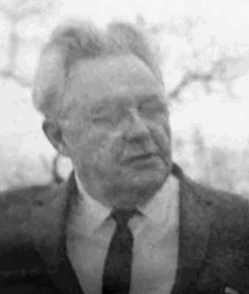 made a big stink and said he knew definitely that the crash at Aztec had taken place and that 12 bodies and the saucer were at Wright-Patterson AFB. made a big stink and said he knew definitely that the crash at Aztec had taken place and that 12 bodies and the saucer were at Wright-Patterson AFB.
Despite the intense level of fame he achieved over 1974-1975, Robert Spencer Carr has gone on to be the unsung “hero” of the crashed saucer conspiracy craze. His contribution was largely excised because it was dependent on Scully’s book, but the concept he inspired remained.
Naturally, Stringfield eventually looked him up and paid him a visit on a trip to Florida. Carr told Stringfield he had looked into the case independently (of Scully’s book) and even declared to Stringfield that it was the “ancestor” of all retrieval cases. “I have spent 17 years collecting the data I have on the Aztec case,” Carr told Stringfield. “I know of other retrievals, but my main thrust through all those years was concentrating on sources who knew about the Aztec incident. I could write a book about that one retrieval alone.”
My point is not to digress upon the Aztec case and give it credibility. My point is that the man, Spencer Carr, who had become the highly publicized focal point of saucer crashes in New Mexico, and with this was the megaphone for alien autopsies and secret saucer wrecks at Wright-Patterson, had considered this February 1948 alleged crash the “ancestor” of them all. Stringfield now agreed. Thus no one in those years since Carr attained an unusual amount of fame (1974) until the time of Stringfield’s publication (1978) had come forward to contact either man and say “Roswell” or anything 1947.
By this time, nothing pointed to Roswell and 1947 among UFOlogists. Moreover, everything through official records until February 1953 reflected a complete skepticism about the existence of flying saucers.
These once SECRET documents (and others) do indeed severely cripple the idea of saucer crashes in New Mexico in 1947-’48, and that is why and how they have been used by debunkers. They are used to counter a popular narrative of “The Roswell Incident.”
However, such documents do not pertain to a time period thereafter. Implicitly and explicitly, two scientists have stated knowledge that saucers were recovered between 1953 and 1960, not before. If correct, the above documents (and others) used to dispel Roswell have no bearing on whether saucers have actually been recovered, as each document dates before the fact.
These two scientists are Canadian electronics engineer Wilbert B. Smith, and a scientist once written up as a boy wonder, Dr. Robert I 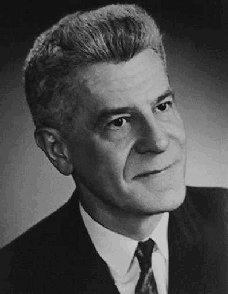 Sarbacher. Smith was head of Project Magnet in Canada, and Sarbacher was an American physicist/engineer and student of Dr. Einstein. Sarbacher. Smith was head of Project Magnet in Canada, and Sarbacher was an American physicist/engineer and student of Dr. Einstein.
Wilbert B. Smith. He dogmatically believed aliens were among us.
Ironically, most pro-crash saucer buffs have not followed the clues these gentlemen have left. They have not done so because these clues did not fit in with the popular narrative of Roswell.
We do so here now.
The prime reason why Sarbacher’s and Smith’s statements have not been followed through to lead to completely independent crash cases (from Roswell) is found in a peculiar discovery. This was a set of notes made by Smith of his conversation with Dr. Sarbacher. Wilbert Smith was visiting Washington D.C. representing Canada on wavelength allocation. At one point he visited Dr. Sarbacher. After the conversation, Smith returned to his hotel room and jotted the conversation as best he could remember. This conversation, however, occurred on September 15, 1950, and yet within it there seems to be the implicit knowledge that saucers have crashed already, a fact that seems impossible from the CIA paperwork. The notes therefore are up to a lot of interpretation. Pro-Roswellers, of course, interpret the statements to support Roswell, and for that reason take it no further.
We best look at the notes ourselves.
WBS: I am doing some work on the collapse of the earth’s magnetic field as a source of energy, and I think our work may have a bearing on flying saucers.
RIS: What do you want to know?
WBS: I have read Scully’s book on the saucers and I would like to know how much of it is true.
RIS: The facts reported in the book are substantially correct.
WBS: Then the saucers exist?
RIS: Yes, they exist.
WBS: Do they operate as Scully suggests on magnetic principle?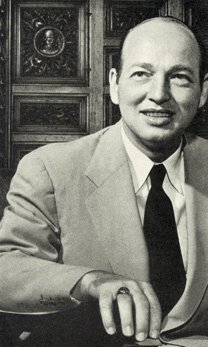
RIS: We have not been able to duplicate their performance.
WBS: So they come from some other planet?
RIS: All we know is, that we didn’t make them, and it’s pretty certain they didn’t originate on the earth.
Physicist and engineer Robert Irving Sarbacher, one of Einstein’s students. He was a dollar-a-year-man in the early 1950s in Research and Development with the Department of Defense. When asked decades later, Sarbacher only vaguely remembered Smith.
WBS: I understand the whole subject of saucers is classified.
RIS: Yes, it is classified two points higher than the H-bomb. In fact, it is the most highly classified subject in the U.S. government at the present time.
WBS: May I ask the reason for this classification?
RIS: You may ask, but I can’t tell you.
WBS: Is there any way in which I can get some information, particularly as it might fit in with our own work?
RIS: I suppose you could be cleared through your own Defense Department and I am pretty sure arrangements could be made to exchange information. If you have anything to contribute we would be glad to talk it over, but I can’t give you any more at the present time.
This is not verbatim, but Smith states it is close— these are his notes which he put down soon after returning to his hotel room, and no doubt it is somewhat truncated.
But as the reader can perceive, nowhere in them is it implied that Sarbacher based his dogma on firsthand knowledge of crashed saucers. He merely said in general that Scully’s book was accurate. Was he talking about the crashes (which are only mentioned in chapter 12) or some of Scully’s other assertions about magnetic principles of flight? In 1983, researcher William Steinman had found Sarbacher was still alive. He wanted to know. He wrote to him on September 12, 1983, and got to the point quickly, asking about crashed saucers and alien bodies. Sarbacher wrote back in the positive. Yet though Sarbacher seemed positive, the wording indicated it was stuff he had been told. One answer was dynamite:
“There were reports that instruments or people operating these machines were also of very light weight, sufficient to withstand the tremendous deceleration and acceleration associated with their machinery. I remember in talking with some of the people at the office that I got the impression these ‘aliens’ were constructed like certain insects we have observed on Earth, wherein because of the low mass the inertial forces involved in operating of these instruments would be quite low. . . .I still do not know why the high order of classification has been given and why the denial of the existence of these devices.”
Sarbacher had answered Steinman on November 29, 1983. Obviously, the response was so phenomenal, it wasn’t long before Stan Friedman, still hot on the trail of Roswell, called for clarification. It was December 1983, and Friedman recorded the conversation. In part:
Sarbacher: I was told that they had recovered a UFO with some people in it.
Friedman: Bodies, whatever.
Sarbacher: I don’t know, that’s what I think I was told.
Friedman: Did he tell you where?
Sarbacher: Well, we were having a meeting at Wright Field and I couldn’t go.
Friedman: Oooohh
Sarbacher: But later on one of the fellows said to me that those guys, if
they were people, were made like insects. They didn’t have any
skin on their bodies.
Friedman: Hmmm.
Sarbacher: So they were saying that’s how they were able to accelerate and
decelerate without being torn apart. You see if we were going
a thousand miles a second and stopped in a minute; well, we would be
squished.
Sarbacher clarified it was one of the guys on the Research and Development Board (of the Department of Defense) from whom he had heard about the saucers and their occupants. Pressing him to get specific, Friedman asked him if he could recall where the crash had occurred. Sarbacher could only remember “somewhere out west.” When asked “any idea what year this was?” Sarbacher associates it with an old colleague’s tenure, Dr. Karl Compton. He said Fred Darwin would also know. Since these men were in their posts in the early 1950s, that’s when this crash happened.
As a time frame for Roswell the early 1950s didn’t fit, and it seemed the conversation was becoming of less importance to Friedman. Now 75 years old, Sarbacher could only remember the talk surrounded a saucer being recovered. As for any conversation with a Wilbert Smith, he could only vaguely recall such a man. And the reason why he couldn’t tell Smith the reason for the high level of security around saucers was probably because he didn’t know himself! Friedman also noticed that the Smith notes of September 15, 1950, didn’t mention a crashed saucer. “Do you think it could have happened after this? [September 1950]. Sarbacher responds that he doesn’t know. “There may have been several of them. There was talk there were. . .”
At this Friedman lights up with interest. “Ah!”
Still, Friedman makes very little use of Sarbacher’s information in his 1992 book Crash at Corona. His co-author, Don Berliner, sums up Sarbacher’s conversations with Friedman, declaring it revealed no “smoking gun,” but his credentials were impressive. “Clearly, wreckage and probably bodies were at Wright Field in the early 1950s.”
By 1992 this rationalization was long in the tooth. It had been standard practice since Charles Berlitz and William L. Moore published The Roswell Incident in 1980, the first book on the topic of Roswell. A good example of the same rationalizing is found when Berlitz misrepresents Stringfield: “Among many researchers of the Roswell Incident, Len Stringfield has been especially concerned about the physical appearance of the occupants of the so-called flying disc. He has been able, in the course of his investigations, to speak with doctors (unidentified at their urgent request) who were summoned by governmental agencies in the early fifties and employed in what was apparently a new series of autopsies, pursuant to whatever autopsies were made in 1947. One wonders why a new series of autopsies was called for: perhaps for comparison data or a renewal of interest in the alleged alien bodies, which, according to Stringfield, were kept in formaldehyde between autopsies— and still are.”
Berlitz rationalizes why witness information only seems to begin in the early 1950s and not before. Instead of being the initial alien autopsies, Berlitz rationalizes them to be a “new series” on the old Roswell bodies. The truth is that the cases in Stringfield’s Retrievals of the Third Kind essentially only began around the early 1950s (with the exception of a “witness” who was inspired by Scully’s book.)
Berlitz and Moore’s book was heavily dependent on Friedman’s legwork and research, and perhaps the fad to rationalize all stories of recovered discs and bodies toward Roswell originates with Friedman’s zeal to establish the case. But thanks to Stringfield we know the rumors begin later, in the early 1950s, and they ripple out from Wright-Patterson AFB, not from the deserts of New Mexico. Reports of recovered saucers and their alien occupants were long established at the base by 1978 when Friedman took up the bloodlust for Roswell.
It is unthinkable that there can be any other source for the repeated rationalizations of the Wright-Patterson data than Stanton Friedman. He alone had single vision. He alone got “witnesses” to talk about Roswell. Despite Carr’s publicity surge drawing nothing out on Roswell, Friedman emerges in 1978 feverishly trying to prove Roswell and only one year later he claimed to have spoken to two dozen people in New Mexico who could verify Marcel’s words. . . .Yet as his 1992 book Crash at Corona reveals, Friedman had a tendency to rationalize all data to fit Roswell. It became standard form in investigating Roswell to take all of Stringfield’s witness reports of Wright-Patterson’s shadowy hangars, recovered saucers and alien bodies in the early 1950s and connect them to a dubious 1947 case.
To underscore how damning it was for Friedman to reshape Sarbacher’s memory of events at Wright-Patterson in the early 1950s we have to compare it to how Spencer Carr, so discredited for good reasons, did the same thing. Carr interpreted the rumors about alien bodies and crashed discs at the Air Force base as being associated with the only crash he had ever heard about— Scully’s crash of a saucer at Aztec, New Mexico, in February 1948. He pulls the neglected tome out of his bookshelf and begins a successful lecture tour. Likewise Friedman does the same thing with Roswell. The only difference with Friedman is that he had published newspaper accounts, Jesse Marcel, and a few other people from 1947 who supported the reports that unusual fragments were found on Brazel’s ranch near Roswell. Avoiding Scully’s book like the plague and expanding on these contacts and filling in the gaps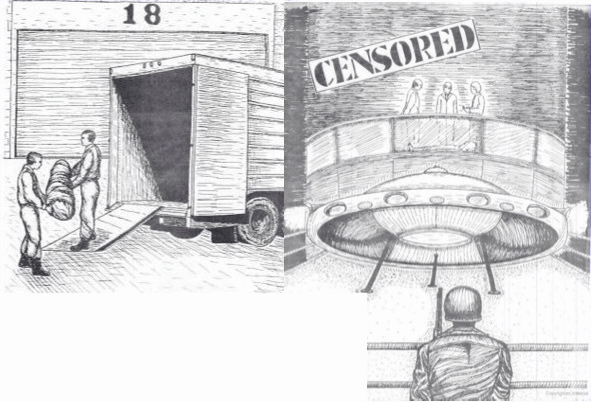 with conspiracies and coverups is what spared Friedman the same ignominious fate suffered by Carr. with conspiracies and coverups is what spared Friedman the same ignominious fate suffered by Carr.
It is interesting to note, however, that after Spencer Carr became a focal point, 3 people did emerge to gratuitously elucidate. Two were former AF men and one was a nurse. The information was not specific to Aztec, though. It revolved, once again, around Wright-Patterson AFB and what was kept there.
Following the strongest scent is always the best. And prior to all the muck on Roswell, the strongest scent in the world of retrievals of the third kind always began at Wright Patterson AFB. Imagining this base as the center of a web, we can regard the witness statements as the individual strands that lead to and from it. A couple are vital for establishing a workable chronology. The most distinguished strand comes from Dr. Sarbacher.
Although his memory was sketchy in 1983, the most important bits remained consistent. And for this reason Stanton Friedman’s interaction with him is valuable, in that it preserves how Wright-Patterson AFB and alien bodies were Sarbacher’s clearest and most indelible memories. Furthermore, in his 1992 book Crash at Corona, his co-author Don Berliner writes:
A further contact with him was made in 1985 by Dr. Bruce Maccabee, a U.S. Navy physicist who heads the Fund for UFO Research. Dr. Sarbacher told him “There is something I should have done but didn’t do. I had a request to visit a site [Maccabee notes: He thinks the request came from Wright Field or that the site was Wright Field] regarding a fallen UFO and at that time could not go, [being] tied up with personal business. But some of the men did go. I went to the office [of the Research and Development Board] some time after they got back and talked to some of the guys who saw it. I wish I could have gone.” Maccabee asked him to relate his impression of what the men told him they saw. “My impression of what the men said who took the trip to Wright Field: the ‘people’ who operated those things were built different than we. They seemed to have no inertia, seemed to be like insects, maybe they were robots [Maccabee’s note: This seemed to stick particularly in his mind].
As Maccabee’s notes preserve, the alien physiology was of real interest to Sarbacher. He had made a point of it with Steinman and with Friedman, and then with Maccabee. In that phone conversation with Friedman, Sarbacher said they didn’t have skin. In other words, they had an exoskeleton, a hard shell or membrane with thinner membranes at the joints to allow mobility, like many insects.
Along with a tendency to rationalize everything toward Roswell, this description too may have made Friedman dismiss (and publicly omit) most of Sarbacher’s memories. His image of aliens was quite different than the popularized image of little gray, melon-headed men. This image had been made popular by Betty and Barney Hill’s claims in the 1960s. It was the first alien abduction that seemed documented by acceptable scientific standards, and Friedman believed in their encounter.
Like Berlitz and Moore, Berliner and Friedman cherry pick what they want. Stan Friedman and Don Berliner also wanted Roswell and a 1947 crash and recovery. Any bodies sighted in the early ’50s must be from 1947. Sarbacher’s sketchy memory therefore was used largely to imply more than one crash. Therefore, by their rationalization, Roswell is possible.
On the contrary, Robert Sarbacher had confined his memories to the early 1950s and to the early time of the Eisenhower Administration. He was speaking about a recent crash. Underscoring that Sarbacher’s memory was hinging on the early 1950s, he had replied to Steinman that “My association with the Research and Development Board under Dr. Compton during the Eisenhower Administration was rather limited so that although I had been invited to participate in several discussions associated with the reported recoveries [those at Wright Field], I could not personally attend the meetings.”
Regarding what he had heard, Dr. Sarbacher was actually quite consistent when talking about a time period. It was the Eisenhower Administration in the early 1950s.
The Eisenhower Administration began on January 20, 1953.
This is a very pivotal time period in the development of the UFO phenomenon.
Up to this time, the Air Force maintained a rather open policy on flying saucers. Major Donald Keyhoe’s soon-to-be bestseller Flying Saucers From Outer Space would owe its immense success to the fact that Al Chop, the Air Force PR man, was able to clear dozens of official sighting reports for the book. These reports were made by military pilots and sometimes they were quite sensational. They came direct from Air Technical Intelligence investigations. In very late February 1953, Al Chop resigned, ready to go into private industry. He told Keyhoe the factions within the Air Force were still bickering about what to make public. The debate was over releasing the controversial Utah Film— footage of a flock of oval, glowing objects flying over Tremonton, Utah, and taken by Navy photographer Delbert Newhouse in the summer of 1952. They wouldn’t do it, but they cleared Keyhoe to write about the film. Chop also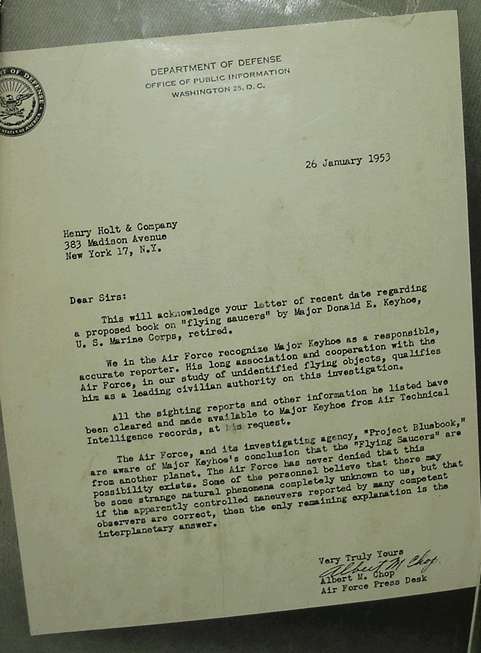 told Keyhoe about the CIA’s secret panel (the Robertson Committee), but couldn’t tell him their conclusion. This was Keyhoe’s last good inside information. told Keyhoe about the CIA’s secret panel (the Robertson Committee), but couldn’t tell him their conclusion. This was Keyhoe’s last good inside information.
The back of Keyhoe’s best seller carried a letter by Chop confirming they had released the documents to Keyhoe.
By summer, the Air Force had radically changed its open policy on flying saucers. Keyhoe could get nothing cleared. He was frustrated. In July, he wrote his upcoming book’s epilogue: “Five months have passed since I learned of the secret Intelligence analysis. Few sightings have been made public in that time. . .”
Keyhoe soon discovered what had been going on in the summer of 1953. He opened his next book The Flying Saucer Conspiracy (1955) exposing the startling and drastic changes. “For several years the censorship of flying saucer reports has been increasingly tightened,” began Keyhoe in Chapter 1 (entitled “Blackout”). “In the United States this top-level blackout is backed by two strict orders.”
The first came about in August 1953. “Known as JANAP 146 [then-current revision], this order sets up a top-priority radio system of the most urgent Intelligence reports. Pilots are directed to report Unidentified Flying Objects (UFO’s) immediately from all parts of the world, using the emergency system— and to keep these sightings secret. . . .Under Section III any pilot who reveals an official UFO report can be imprisoned for one to ten years and fined up to 10,000 dollars (Title 18, U.S. Code, 793.) . . .Three months later, in December 1953, I discovered the second order, which carries court martial penalties . . .” In December 1953, the Air Force ceased and “refused” to release any more sightings reports.
Thus began Keyhoe’s descent into conspiracy. It was evident that the Air Force, which so often had ridiculed and made light of UFO reports, now was taking them so seriously that rules with heavy punishments were being enacted. It all began to coalesce in the summer of 1953.
Obviously there had to be a cause. From what we’ve been able to extract from Dr. Sarbacher’s memory, he associated a saucer crash with the Eisenhower Administration, not before. The “talk” came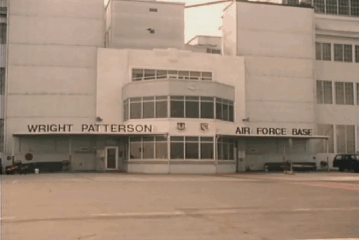 from the Research and Development Board guys who had gone to Wright-Patterson AFB for a meeting, a meeting he could not attend. from the Research and Development Board guys who had gone to Wright-Patterson AFB for a meeting, a meeting he could not attend.
Wright-Patterson AFB is a major center for project development. It is central in the legend of Roswell. Len Stringfield’s informants spoke of bodies here in the 1950s. Roswellers merely cannibalized these accounts to imply these were from the Roswell crash. Yet none of his informants ever implied a crash at Roswell. According to Dr. Sarbacher, it was actually in 1953 that a discussion was held here on a crashed saucer and recovered bodies.
One possible cause for the changes is the crash of an actual saucer. We will pursue this theory here.
Before the crashed saucer syndrome begun by Carr in 1974, a scientist named Arthur G. Stansel approached a respected UFO investigator named Ray Fowler. He told him he had been a project engineer with the Atomic Energy Commission on Operation Upshot Knothole, being employed at Wright-Patterson AFB (from 1949 to 1960). These tests took him to assignments in Nevada working on atomic blast effects on various types of buildings. On May 20, 1953, he had received a call from the supervisor, Dr. Edward Doll, that he would be needed tomorrow (May 21) for a special assignment. Along with other scientists, on May 21, 1953, he was seconded from his work and driven to Indian Springs AFB, Nevada. He and other scientists were flown to Luke AFB in Arizona, near Phoenix. From there they were taken in a bus with blacked-out windows to some undisclosed location about 4 hours away. It was nighttime, May 21, 1953, when they disembarked the bus. From what they could see of the topography, it was flatland desert. There skidded into in the desert was a silver disc. They were set to examine and study it.
Now 20 years later in 1973, Stansel confided the details of his involvement. He wanted his identity protected. Fowler would refer to him by the alias “Fritz Werner.” This is what Stansel had told him (in an affidavit June 7, 1973).
The object was constructed of an unfamiliar metal which resembled brushed aluminum. It had impacted twenty inches into the sand without any sign of structural damage. It was oval and about 30 feet in diameter. An entranceway hatch had been vertically lowered and opened. It was about 3-1/2 feet high and 1-1/2 feet wide. I was able to talk briefly with someone on the team who did look inside only briefly. He saw two swivel seats, an oval cabin, and a lot of instruments and displays.
A tent pitched near the object sheltered the dead remains of the only occupant of the craft. It was about 4 feet tall, dark brown complexion and had 2 eyes, 2 nostrils, 2 ears, and a small round mouth. It was clothed in a silvery, metallic suit and wore a skull cap of the same type material. It wore no face 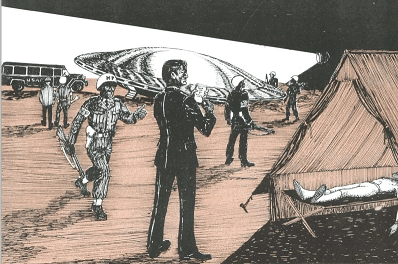 covering or helmet. covering or helmet.
Britain’s Flying Saucer Review gave an artistic representation of Stansel’s account the cover on the July 1979 issue that introduced Len Stringfield’s Retrievals of the Third Kind. Fowler had shared it with Stringfield, who thought it was potentially one of the best cases.
“Oval” was not the popular concept of a flying saucer in 1973 anymore. Yet it is the original description from the earliest reports of aerial sightings in the late 1940s. These reports were soon forgotten because within the popular forum the oval shape was replaced with a round disc with a central dome on top. In further conversations with Fowler, Stansel elaborated:
. . .Two spotlights were centered on the crashed object, which was ringed with guards. The lights were so bright that it was impossible to see the surrounding area. The object was oval and looked like two deep saucers, one inverted upon the other. It was about thirty feet in diameter with convex surfaces, top and bottom. These surfaces were about twenty feet in diameter. Part of the object had sunk into the ground. It was constructed of a dull silver metal like brushed aluminum. The metal was darker where the saucer “lips” formed a rim, around which were what looked like slots. A curved open hatch door was located on the leading end and was vertically lowered. There was a light coming from inside, but it could have been installed by the Air Force.
My particular job was to determine from the angle and the depth of impact into the sand, how fast the vehicle’s forward and vertical velocities were at the time of impact. The impact had forced the vehicle approximately twenty inches into the sand. There were no landing gear. There also were no marks or dents, that I can remember, on the surface— not even scratches. Questions asked, having nothing to do with our own special areas, were not answered.
An armed military policeman guarded a tent pitched nearby. I managed to glance inside at one point and saw the dead body of a four foot human-like creature in a silver metallic-looking suit. The skin on its face was dark brown. This may have been caused by exposure to our atmosphere. It had a metallic skullcap device on its head. face was dark brown. This may have been caused by exposure to our atmosphere. It had a metallic skullcap device on its head.
Clay model made by Quasar approximating an oval shape disc with an oval convex top and bottom smaller in diameter than the lip of the disc.
Fowler investigated carefully and discovered that Stansel was considered reliable. He even looked at Stansel’s daily diary. Two entries were intriguing— those for May 20th and 21st, 1953:
Spent most of the day on Frenchman’s Flat surveying cubicles and supervising welding of plate girder bridge sensor which cracked after last shot. Drank brew in eve. Read. Got funny call from Dr. Doll about 1000. I’m to go on a special job tomorrow.
The 21st:
Up at 7:00. Worked most of day on Frenchman with cubicles. Letter from Bet. She’s feeling better now— thank goodness. Got picked up at Indian Springs AFB for a job I can’t write or talk about.
Stansel’s credibility has to soon be considered here. Before we do so, the juxtaposition of May 21, 1953, and his description of the saucer must be put in context again. When Stansel confided his account to Fowler in 1973, no one thought a saucer was shaped like an oval anymore. They were round pie plates with domes. Sarbacher’s memories are of a crash happening during the early ’50s in the Eisenhower Administration. Donald Keyhoe documents how the 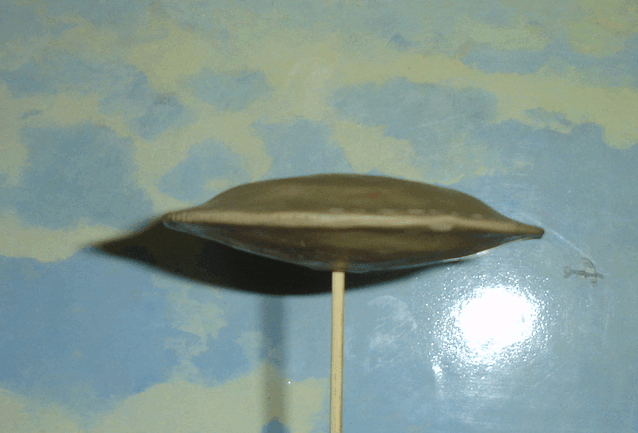 Air Force underwent a major change in attitude toward flying saucers beginning in the summer of 1953. Their reporting became an immediate and important affair that was to remain secret. Air Force underwent a major change in attitude toward flying saucers beginning in the summer of 1953. Their reporting became an immediate and important affair that was to remain secret.
Same saucer above seen oncoming— it fits with the early reports of a lentil.
Only an analysis of the entire flying saucer phenomenon to date could reveal how a network of clues converge in mid 1953. At present, only one event seems to explain them— the crash that Stansel said happened in late May.
Some support for Stansel’s claims is found intrinsically in the measurements he provides. All measurements are approximate. Aliens would not be building their craft according to the English Standard of measurement and therefore one would not expect any measurement to come out exactly in feet and inches.
Extrinsically, support for Stansel’s account is found in his description of the craft. If we remain focused on the early flying saucer reports from 1947-1950 as representing the gold standard for assessing the actual design and appearance of the unexplained flying saucer (as opposed to Lightcraft and the flaps and folklore it inspired), then Stansel’s description passes the test.
Relying on this gold standard, the UFO phenomenon takes on remarkable consistency to the present day. The actual unexplained UFOs that do the most remarkable maneuvers remain, in fact, these same ovals. They have never changed.
For example, in 2017 the Pentagon released information that they had reopened an investigation into UFOs. Several alarming encounters had happened that warranted investigation. One of the most spectacular was witnessed by the Pacific fleet on maneuvers in 2004. The USS Princeton was picking up a fleet of UFOs. They were descending from 80,000 feet to 20,000 feet. F-18 Super Hornets were scrambled from the fleet carrier Nimitz. They closed in on their targets. The New York Times summed up the first sighting.
It was calm that day, but the waves were breaking over something that was just below the surface. Whatever it was, it was big enough to cause the sea to churn.
Hovering 50 feet above the churn was an aircraft of some kind — whitish — that was around 40 feet long and oval in shape. The craft was jumping around erratically, staying over the wave disturbance but not moving in any specific direction. . .The disturbance looked like frothy waves and foam, as if the water were boiling.
One of the pilots, David Fravor, started a circular descent to get a better look. The object rose to escape. In his own words: “As I get closer, as my nose is starting to pull back up, it accelerates and it’s gone. Faster than I’d ever seen anything in my life. We turn around, say let’s go see what’s in the water and there’s nothing. Just blue water.” Fravor further stated that the visibility was about 10 miles at his altitude and for a craft to disappear in a couple of seconds it indicated it had technology and speed that “was not of this world.”
The gun camera footage of other Super Hornets is, of course, easily found on Youtube. For those not familiar with the actual foundation of the UFO phenomenon, an oval disc may be surprising but in fact the first saucers were described more frequently like this.
An oval saucer was also involved in one of the most alarming encounters in military history. This occurred in October 1973, during the great autumn flap, to an Army helicopter flying over Ohio and piloted by Captain Larry Coyne. He and his crew (3 other men) documented the sighting. The object had a glowing red nose and came out of the east, zooming in on them like a missile. Coyne took control and started descent. The craft hovered over the chopper and then a funnel of bright green light shone down on them. After several seconds, the craft zoomed up and away. Coyne realized instead of descending the chopper had been taken up 1,800 feet in altitude.
They described the saucer as oval with a dome. However, taking Stansel’s description of an oval with convex surfaces smaller in diameter than the rim, the oval saucer of 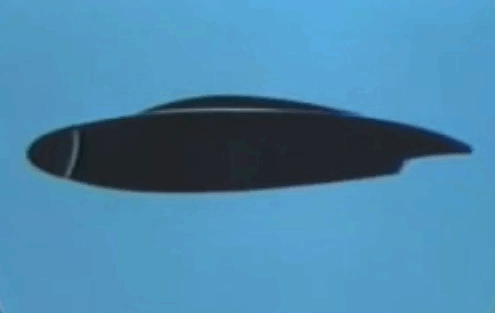 the Arizona crash (from Coyne’s angle) could look like an oval with a dome. the Arizona crash (from Coyne’s angle) could look like an oval with a dome.
Compare Coyne and his crew’s composite with Stansel’s description of the saucer reproduced below in clay.
Only one time was such a saucer discussed as being recovered, and this is the Stansel case in May 1953 just referred to.
Stansel’s account has undergone some attacks, but not many. This isn’t because it is so airtight. It is because Roswell overwhelmed everything with domed discs and little gray, melon-headed aliens. Stansel’s account just didn’t fit. However, until 1980 it was highly regarded. Stringfield featured it prominently in his Retrievals. Stringfield writes: “In my book Situation Red I cover the Werner story in full, based on my conversations with Ray Fowler. Said Fowler: ‘With more substantiation it could blow the lid off secrecy.’ I agree. One final note: the name Fritz Werner is fictitious but I feel his story, although embellished, is basically true.” Yet there is a curious epilogue in this case. It was the only one where there was the need by an unnamed intelligence officer to discredit it with a pithy and negative comment. “One intelligence source commented: ‘A lot of it is story.’”
Compared to the other stories Stringfield presented— of alien bodies seen in cryogenic suspension, etc.— there is little that can be called embellishment in Stansel’s story. Stringfield may have been cautious for another reason. Critics have noted that the first time Stansel told his story to two amateur UFO buffs, they were having drinks and he said the object was a 12 foot teardrop. He later 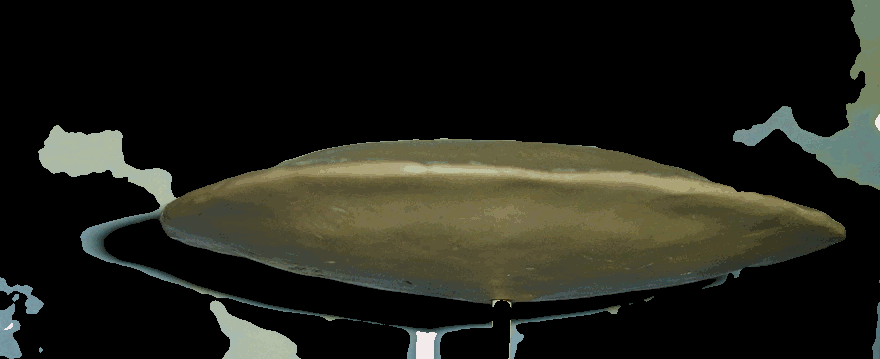 corrected that and said he wasn’t being too serious with them considering how they behaved, and he’d had a little too much to drink. corrected that and said he wasn’t being too serious with them considering how they behaved, and he’d had a little too much to drink.
The clay saucer seen from an upward angle— it can approximate Coyne’s description of the oval with a dome.
It is ironic that such a story as Stansel’s would be considered embellished. Compared to all that would later be written about Roswell, the alleged crash in Arizona is dull by comparison. The names behind the initials and aliases Stringfield used to convey his many stories of crashed saucers and bodies at Wright-Patterson have never been identified. But Fritz Werner eventually was, and he turned out to be the scientist Fowler had confirmed him to be.
Criticism of the Stansel account is increasingly counterbalanced by the many extrinsics. Repeated reports, such as in the Fravor sighting, always underscore the low inertia of these ovals. The original flying saucer sightings inspired the theories of low inertia and insectoid occupants. The saucer Stansel said he examined was undamaged and only skidded 20 inches into the desert, indicating it was very low in inertia. Vintage saucer sightings over Arizona coupled with the fleet encounters in 2004 heavily suggest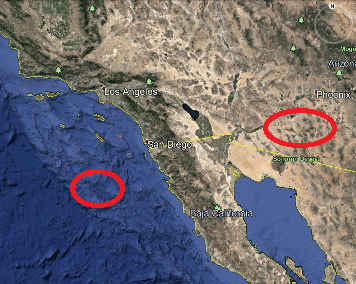 they stick to some basic trajectories. These accounts over Arizona will be dealt with later, but altogether they repeatedly confirm these ovals speed in from the Pacific and later return there. they stick to some basic trajectories. These accounts over Arizona will be dealt with later, but altogether they repeatedly confirm these ovals speed in from the Pacific and later return there.
The fleet was off San Diego in the Pacific in 2004— the area compared to the probable area where Stansel was taken, southwest of Phoenix.
Sadly, Stansel’s saucer crash has been popularized as happening near Kingman, Arizona, because that’s where he and another scientist together deduced they were. But Fowler didn’t really believe that was accurate. In Casebook of a UFO Investigator, he writes:
Through correspondence with the Mohave County historian I found that Kingman was an unlikely place for the incident to have occurred. A four-hour drive at night in a bus with blacked-out windows could have conveyed the investigating team to any number of places. The historian felt that the vast range controlled by Luke AFB, southwest of Phoenix, was a more likely spot for the crash site. He stated that it is a real desert area with packed sand just as Fritz Werner described.
Arguments against the theory that a flying saucer crashed in Arizona should bring up a very pertinent fact— by now, we should have been able to backwork how the saucer worked and incorporate its dynamic propulsion and flight characteristics into our own space and aviation programs. This has obviously not been done.
However, this argument may not entirely be relevant. Whether Sarbacher’s R&D guys really saw the saucer and its occupants, or whether they were just yakking, the answer would be the same. It would still be informed yakking based on their knowledge of physics. The full exploitation of the saucer design, as underscored by numerous sightings, and its propulsion may be dependent on beings of low inertia as well, which we humans are not. Our pilots can withstand only so much, and this caps the limit on how this technology might be harnessed. We theorize that saucers may operate on some fancy principle of antigravity, but none of the evidence implies that. As stated by Sarbacher, the occupants may indeed be insectoid and have a firm exoskeleton like many insects and be able to withstand the speeds and maneuvers of their novel saucers.
By 1955, there were already rumors of a secret saucer program, and Donald Keyhoe, seized up with conspiracy theories, believed it was disinformation. He warned Coral Lorenzen not to buy into it (See Overview). It is interesting to note that in a couple of years a milestone event would happen— the events at Levelland, Texas, just east of New Mexico and the Department of Defense’s development and proving grounds. Long declared a benchmark in UFO visitation, the evidence grows that this was an early appearance of the astounding technology of Lightcraft. But Levelland has its own page.
With the Covid 19 pandemic making the lay population aware of the dangers of exposure to an unknown virus or germ, another argument against a saucer crash can be immediately grasped. The hazards of coming into contact with an alien life form and the exposure of humans to dead or living beings from another world would most likely result in an exchange of germs, some of which could be deadly to us and cause a mass pandemic. Why did this not follow May 1953 or any other time there was supposedly an alien crash?
As the Covid 19 news coverage has also conveyed to the lay public, a virus (especially) would need some bridge to infect mankind from an animal. I’m not sure if a virus can jump from an insect to a human unless the human is bit. If aliens are somewhat more like humanoid insects, no virus may be capable of jumping back and forth and infecting them or us. It may only transmit via respiration, and if the aliens were dead there is no fear of that form of transmittal to humans.
Perhaps all is error. Perhaps Wilbert Smith was crazy when he said they had 3,000 pounds of alien metal in Canada; and perhaps Robert Sarbacher’s memory was too contaminated and unreliable. Perhaps Arthur Stansel was a crank who didn’t know his description was intriguingly at odds with the popular and contrived narrative but in line with the forgotten facts of saucer shapes.
But the gun cameras of F-18 Super Hornets were not subject to mankind’s mental frailties. Fravor describes the giant tic tac of Stansel’s account, and Stansel’s measurements apply to the mysterious flying saucers of 1947.
Chronologically speaking, Stansel’s account of a crash is actually the first one. It came before Spencer Carr popularized the concept. It resides in Stringfield’s Retrievals as that of a witness to a saucer in situ at the crash site rather than the other tales of transshipping a saucer or seeing bodies in deep freeze at a base. It is only after Friedman does the mojo turn in New Mexico that other questionable witnesses come forward and say they came across a saucer in the desert in 1947.
Some of the resuscitated memories of the 1970s and 1980s must be based on something. Sadly, they’ve been used as compote to create Roswell. Yet two memories— Stansel’s and Sarbacher’s— coincide to agree it was the early Eisenhower Administration as the actual time.
Putting all these accounts and coincidences together, it is a legitimate induction to propose that something significant happened just prior to or during the summer of 1953 involving flying saucers. These “coincidences” also make an investigation of this period justifiable in order to uncover more evidence and/or information leading to more evidence.
If we are to even tentatively hold to the theory that a flying saucer did crash in Arizona in May 1953, then we must accept that the lack of its technology in our own aeronautic science is a powerful extrinsic that doesn’t fit the theory. Does this fact favor the early theory aliens are insectoid and of low inertia? Therefore we simply are incapable of fully exploiting this technology. We do have clues upon which to build an inductive thesis. Low inertia, not gravity, is a real barrier. It is part 2 of the Sarbacher Clue.
|